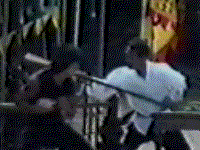What many animators find hard
to understand is just how incredibly fast a fast action actually occurs.
The average Snap action accounts for about 80 to 90 percent of the motion
in a move (the anticipation accounting for the other 10-20 percent).
But the period of an average Snap action is one or two frames, at the most!
These moves happen so fast that you could literally blink and miss them.
Of course, you won't blink, because the anticipating movements will have
cued you to expect something.
If you just don't accept that nine tenths of a punch can happen in a
thirtieth of a second, you'll end up animating snaps that are three or
four frames long. And they will look, I kid you not, awful.
Your punches won't really look like punches until you bite the bullet and
try a heavily anticipated snap of a single frame.
When I first started working with Snap, I wondered "How can something
look so realistic, when I know that real people can't possibly move that
way?" Well, I'll tell you a dirty little secret that I've discovered:
real people actually do move that way.
 Here's a quick little
punch from Jackie Chan (which I sincerely hope I won't get sued over!)
Notice the super slow-motion to the left.. The main movement of the
punch happens in the course of a single frame (told you!) The action
surrounding the punch before and after help the audience to perceive it
correctly, without detracting from its impact. And hey, if you don't
want your animated punches to look like Jackie's, then I just don't understand
you.
Here's a quick little
punch from Jackie Chan (which I sincerely hope I won't get sued over!)
Notice the super slow-motion to the left.. The main movement of the
punch happens in the course of a single frame (told you!) The action
surrounding the punch before and after help the audience to perceive it
correctly, without detracting from its impact. And hey, if you don't
want your animated punches to look like Jackie's, then I just don't understand
you.

Anyway, I guess I've just about talked Snap and Ancitipation to death.
Are you about ready to actually start using this principle in animation?
Great!
Next Page
Previous Page
Back to Tutorials
 Here's a quick little
punch from Jackie Chan (which I sincerely hope I won't get sued over!)
Notice the super slow-motion to the left.. The main movement of the
punch happens in the course of a single frame (told you!) The action
surrounding the punch before and after help the audience to perceive it
correctly, without detracting from its impact. And hey, if you don't
want your animated punches to look like Jackie's, then I just don't understand
you.
Here's a quick little
punch from Jackie Chan (which I sincerely hope I won't get sued over!)
Notice the super slow-motion to the left.. The main movement of the
punch happens in the course of a single frame (told you!) The action
surrounding the punch before and after help the audience to perceive it
correctly, without detracting from its impact. And hey, if you don't
want your animated punches to look like Jackie's, then I just don't understand
you.
